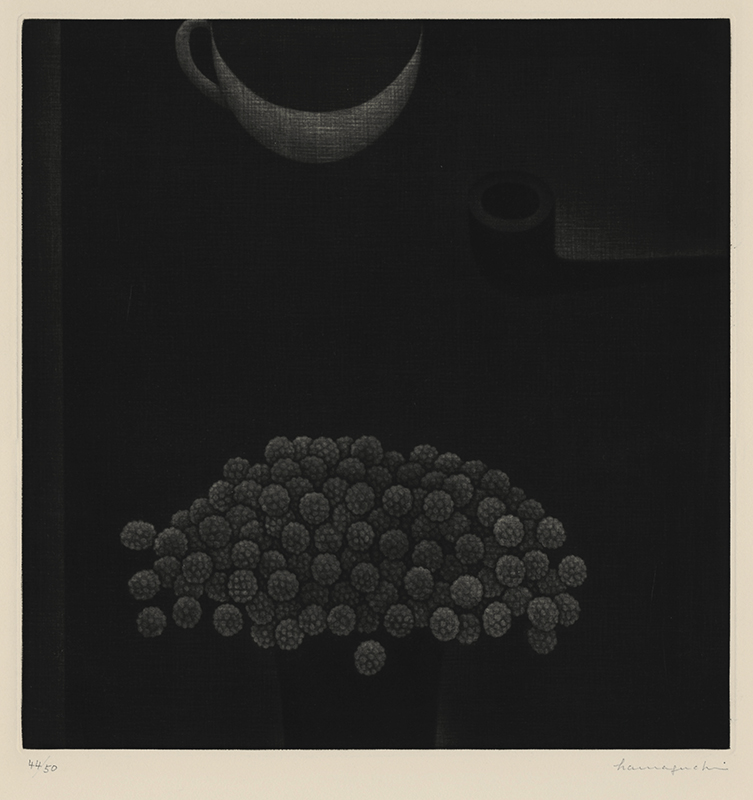Fruits of Clover is a mezzotint from 1957 by the Japanese master of the mezzotint, Yōzō Hamaguchi. It is pencil signed and edition 44/50. Fruits of Clover was published by the artist and was printed on ivory Rives wove paper. The reference for this work is Tokyo Metropolitan Teien Art Museum, plate 22, and the dimensions are 11-1/2 x 11-9/16 inches platemark.
Yōzō Hamaguchi focused on simple manmade or natural objects for many of his mezzotint composition allowing the viewer to rethink their relationship to an object or perhaps see its beauty and delicacy for the first time. Fruits of Clover is a monochromic still life but Hamaguchi added intrigue by changing the picture plane. The vase in the foreground is viewed straight on while the textured porcelain cup and dark pipe are tipped at angles, allowing the viewer a partial glimpse into their circular chambers. With the technique of mezzotint, the artist works from dark to light having to educe his subject out of rich blackness. Hamaguchi mastered the tonal possibilities of gray, using it here as both color and highlight.
Yōzō Hamaguchi, printmaker, was born in Wakayama, Japan in
1909, the son of Gihei, who was the tenth president of the soy sauce producer
Yamasa Shoyu. Originally considered to be the next in line to take over the
company, Hamaguchi was instead drawn to visual arts, inspired by the works that
his father, a Nanga painting collector, kept throughout the house. In
1927 Hamaguchi left the family business to enroll in the Tokyo Art School,
training in sculpture. He left the school in 1930 and moved to France on the
advice of artist Umehara Ryuzaburo, opting to study modern Western art and the
techniques of oil painting, printmaking, and watercolor. He lived there until 1939,
becoming acquainted with leading international artists and luminaries,
including the writer e.e. cummings who was instrumental in introducing him to
mezzotint printmaking.
With the outbreak of World War II, Hamaguchi returned once more to Japan. There he met artist Keiko Minami, whom he would later marry. Throughout the 1940s he established himself as a pioneering mezzotint artist, often credited with introducing the medium to his birthplace. His style - graphic, subtle, and primarily in a monochromatic palette - gained widespread popularity throughout Europe and, in 1951, he held his first solo exhibition at the Formes Gallery in Tokyo. Around 1953 Hamaguchi and Minami returned to France, settling in Paris and, in 1954, he became a member of the Salon d'Automne. That same year he won the Best Art Piece prize at the Contemporary Art Exhibition of Japan. In 1955 he began experimenting with color as well as abstraction, retaining his refined tonality, to acclaim from critics, artists, and institutions. He won the Grand Prize of the International Printmaking Division at the San Paolo Biennial in 1957, and that same year he participated in the first International Biennial Print Exhibition in Tokyo, where he won the National Museum of Modern Art (Tokyo) Prize. In 1960 served as representative of the Japan Pavilion at the Venice Biennale.
Hamaguchi's compositions were usually the still
life genre, simplifying the elements and suspending them against velvety
grounds in a signature style that appealed strongly to western patrons. In 1961
Hamaguchi and Minami moved from Paris to San Francisco, California, where they
lived until 1996. During this time, he was commissioned by the Olympic
Committee to design the official poster for the 1984 Sarajevo Winter Olympics
and the following year he was given his first major retrospective in Japan at
the Toyo Yurakucho Art Forum. Hamaguchi continued to work and exhibit his
mezzotints until his retirement in 1993, leaving the printing of his plates to
his publisher. He and Minami returned to Tokyo in 1996, and in 1998 the Musée
Hamaguchi Yozo was established in Tokyo.
Yōzō Hamaguchi died in Tokyo on December 25, 2000.



